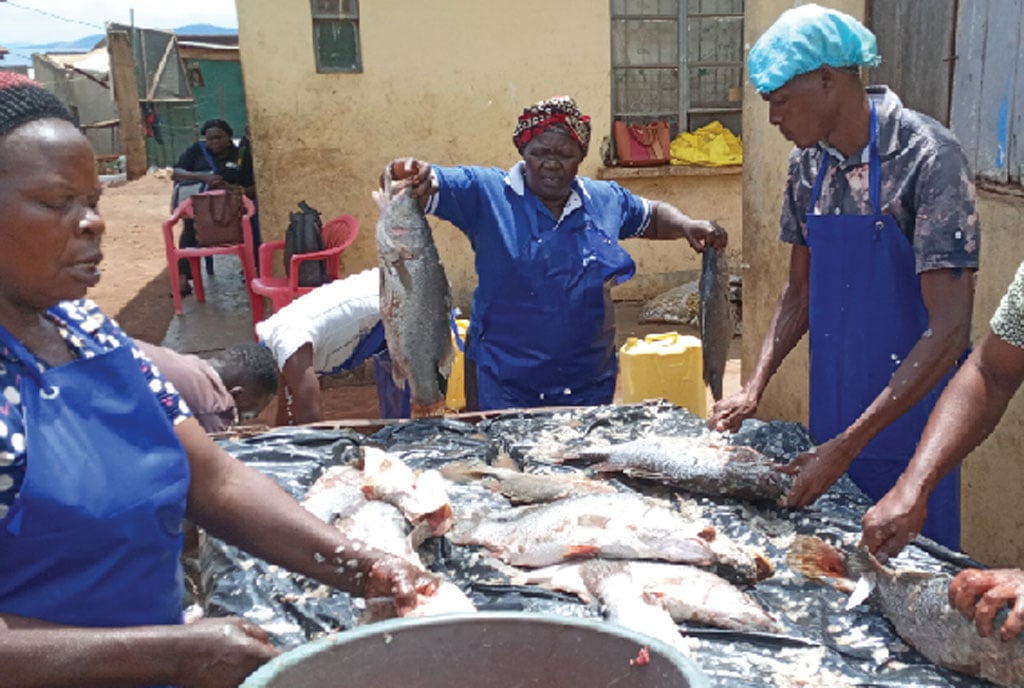Prime
Women benefit from fish smoking kilns

Ladies under Women of Hope Katosi fish processors prepare fish for smoking. PHOTO/LOMINDA AFEDRARU
What you need to know:
- Until recently, local fish processors were entirely dependent on traditional methods to smoke fish.
- However, women groups such as Women of Hope Katosi fish processors have managed to reap benefits from acquiring a smoking kiln.
Smoking and drying are important fish processing methods for small scale fisheries in countries geographically located around the tropics including Uganda. Fish is highly perishable therefore the need for fish processors to smoke it in a bid to prolong its lifespan.
Smoked fish is more necessary when poor infrastructure and inefficient cold chain impede the supply of fresh fish into the available market.
Experts define fish smoking as a process of treating fish by exposing it to smoke from heated wood or plant materials.
This process is usually characterised by a combination of salting, drying, heating and smoking steps in a smoking chamber while drying is done to reduce moisture content to at least 10 percent or less.
Background
Overtime fish processors have been smoking fish using traditional methods where firewood is used to generate heat.
Experts contend that fish smoking using firewood increases the risk of contamination with by-products of combustion such as Polycyclic Aromatic Hydrocarbons (PAHs) and other contaminants.
PAHs can be carcinogenic and can affect the safety of food. In addition, using traditional methods can lead to loss of the by-products such as oil and it takes much longer time for processing. This has led to Uganda’s smoked fish being barred in the export market because of poor quality.
It possess cancer-causing compounds amounting to 40,000 parts per billion (ppb) way beyond the one recommended by the World Health Organisation which is 5 ppb.
As such scientists at the Agricultural Engineering and Appropriate Technology Research Centre (AEATREC) at Namalere developed a modern fish smoking kiln to help solve the challenge.
The scientists have distributed the kilns at subsidised price to various women groups dealing in processing fish at various landing sites in a bid to earn better from smoked fish and improve their livelihoods.
Seeds of Gold interacted with some of the women groups during a fact finding visit and below are the details.
Fabrication of fish kiln
Dr Alphonse Candia from AETREC who developed the technology explains that the initial work started in 2014 after fish exports from Uganda were barred in the EU market because it was contaminated.
By 2019, the fabrication work was completed with the first bunch of smoking kiln with one chamber developed. However the team kept on improving the technology and in 2021 the scientists launched the technology with types namely NAROFIK-3-D, NAROFIK-3-D4 and NAROFIK-3-D6, an improved fish smoking and drying oven technology.
The ovens have capacity of drying between 200 and 700 kilogrammes of fish. They cost Shs50m and Shs70m depending on their sizes but the women groups acquired it under an arrangement where they pay half of the overall cost on instalment.
How it works
The smoking kiln series comprise a number of components including a smoke generating unit where fresh tree leaves are placed to sieve and filter clean smoke in order to obtain the right flavour and aroma.
There is the smoke delivery system which conveys the smoke into the filter and thereafter to the dehydration chamber which filters the smoke.
The dehydration chamber contains stainless steel mesh where fresh fish is placed on for the drying process.
In the last chamber, a flavoured filtered smoke is imparted on the fish after which the fish is dehydrated to the required consumer taste and hardness.
There is the chamber for generating fire to provide heat and this is done by lighting charcoal whose consumption is minimal.
Once the heating process starts it takes about 12 hours for it be dry. However after six hours the fish can be changed to ensure both sides are dry.
Beneficiaries
Perus Logoso is the director Kiyindi Women Fish Processors Association. Logoso says she organised the women in 2010 after attending several training sessions about fish processing from various stakeholders including experts from Food and Agriculture Organisation (FAO). The training was mainly on silver fish processing to raise awareness and draw the attention of the public towards consuming silver fish.
“A number of us in the group were sensitised on how to fry silver fish by including spices and make snacks ready for consumption. This followed with demonstration of drying silver fish on raised racks. We began moving to places such as Entebbe, Lugazi and Jinja to sensitise women on silver fish value addition and now we are supplying in supermarkets in major towns in the country,” says Logoso.
According to Logoso, the fish smoke kiln has improved smoking system and the energy used is minimum and her group is able to smoke 1 ton of fish within the shortest time.
The women purchase high quality fresh fish each three kg costing Shs10, 000 but upon smoking it is sold at Shs30, 000 or more depending on the available market.
The two-chamber kiln accommodates one tonne of fish at ago during the smoking processing
They are able to sell three tons or more in a duration of two weeks. The group comprise of 40 members and they save money obtained from fish business and the profits are shared at appropriate time when there is enough proceeds.




